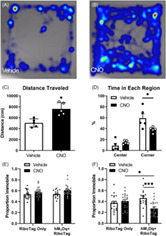- Record: found
- Abstract: found
- Article: found
PACAP‐expressing neurons in the lateral habenula diminish negative emotional valence

Read this article at
Abstract
The lateral habenula (LHb) is a small, bilateral, epithalamic nucleus which processes aversive information. While primarily glutamatergic, LHb neurons express genes coding for many neuropeptides, such as Adcyap1 the gene encoding pituitary adenylate cyclase‐activating polypeptide (PACAP), which itself has been associated with anxiety and stress disorders. Using Cre‐dependent viral vectors, we targeted and characterized these neurons based on their anatomical projections and found that they projected to both the raphe and rostromedial tegmentum but only weakly to ventral tegmental area. Using RiboTag to capture ribosomal‐associated mRNA from these neurons and reanalysis of existing single cell RNA sequencing data, we did not identify a unique molecular phenotype that characterized these PACAP‐expressing neurons in LHb. In order to understand the function of these neurons, we conditionally expressed hM 3Dq DREADD selectively in LHb PACAP‐expressing neurons and chemogenetically excited these neurons during behavioral testing in the open field test, contextual fear conditioning, sucrose preference, novelty suppressed feeding, and conditioned place preference. We found that Gq activation of these neurons produce behaviors opposite to what is expected from the LHb as a whole—they decreased anxiety‐like and fear behavior and produced a conditioned place preference. In conclusion, PACAP‐expressing neurons in LHb represents a molecularly diverse population of cells that oppose the actions of the remainder of LHb neurons by being rewarding or diminishing the negative consequences of aversive events.
Abstract
Related collections
Most cited references66
- Record: found
- Abstract: found
- Article: not found
Genome-wide atlas of gene expression in the adult mouse brain.
- Record: found
- Abstract: found
- Article: not found
Evolving the lock to fit the key to create a family of G protein-coupled receptors potently activated by an inert ligand.
- Record: found
- Abstract: not found
- Article: not found
